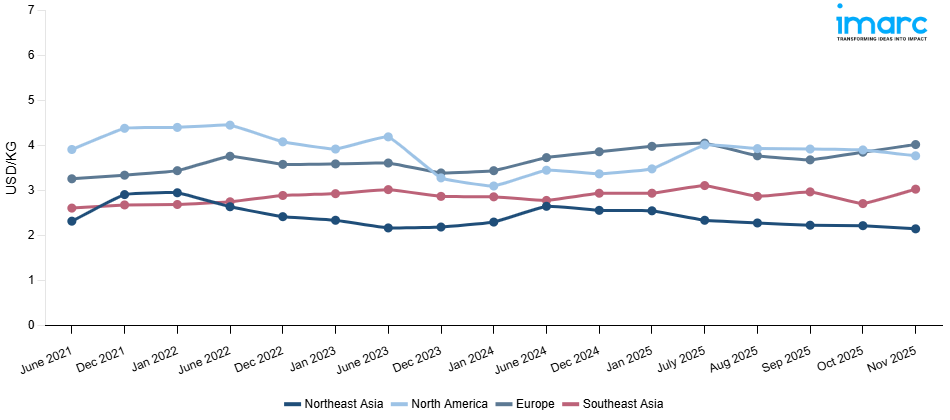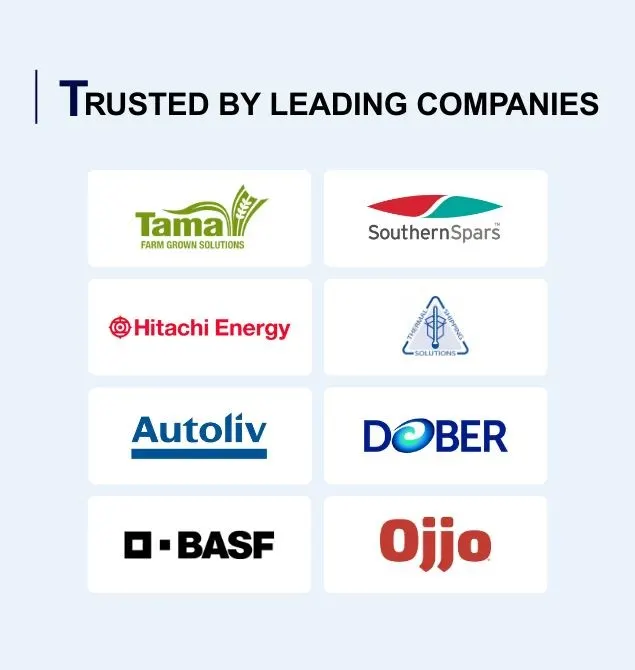
Polymethyl Methacrylate (PMMA) Prices, Trend, Chart, Demand, Market Analysis, News, Historical and Forecast Data Report 2025 Edition
Polymethyl Methacrylate (PMMA) Price Trend, Index and Forecast
Track real-time and historical polymethyl methacrylate (PMMA) prices across global regions. Updated monthly with market insights, drivers, and forecasts.
Polymethyl Methacrylate (PMMA) Prices November 2025
| Region | Price (USD/KG) | Latest Movement |
|---|---|---|
| Northeast Asia | 2.15 | -3.1% ↓ Down |
| Europe | 4.02 | 4.5% ↑ Up |
| Southeast Asia | 3.03 | 11.8% ↑ Up |
| North America | 3.77 | -3.4% ↓ Down |
Polymethyl Methacrylate (PMMA) Price Index (USD/KG):
The chart below highlights monthly polymethyl methacrylate (PMMA) prices across different regions.

Get Access to Monthly/Quaterly/Yearly Prices, Request Sample
Market Overview Q3 Ending September 2025
Northeast Asia: The pricing pressure was influenced by multiple demand- and supply-side factors. On the demand side, reduced consumption in the automotive and electronics sectors in countries like China, Japan, and South Korea, driven by inventory adjustments and slower manufacturing cycles, contributed to the moderated pricing. On the supply side, stable monomer (MMA) feedstock availability and relatively low import tariffs allowed manufacturers to maintain production efficiency, mitigating upward pressure on prices. Logistics costs, including port handling and domestic transportation, remained steady; however, currency fluctuations, particularly the appreciation of the Japanese yen against the USD, slightly offset local pricing. Additionally, compliance with quality certifications and environmental regulations in South Korea and Japan increased operational costs marginally but did not significantly impact regional pricing.
Europe: The price evolution was shaped by a combination of domestic and international factors. Demand from construction, automotive, and medical device industries remained consistent, while certain sectors, including signage and lighting, experienced temporary softness due to energy cost pressures. On the supply side, disruptions in shipping routes and port congestions in Northern European countries slightly affected delivery timelines, indirectly influencing pricing strategies. Currency fluctuations, notably the euro against the USD, also contributed to regional pricing adjustments. Furthermore, European manufacturers faced compliance costs associated with environmental and product quality standards, including EU REACH regulations, adding marginally to production expenses.
Southeast Asia: Rising demand in the region’s growing automotive, electronics, and consumer goods sectors primarily drove the price increase, particularly in Thailand, Malaysia, and Vietnam. Supply-side factors, including limited regional production capacity and reliance on imported MMA monomers, further pressured prices. International shipping costs, impacted by seasonal disruptions, elevated freight expenses, while port handling charges in major hubs like Singapore and Port Klang added to overall delivery costs. Currency volatility, particularly the depreciation of local currencies against the USD, influenced imported feedstock costs, contributing to higher final pricing. Additionally, compliance with environmental regulations and safety standards added moderate cost layers for manufacturers. Collectively, Southeast Asia exhibited strong pricing momentum in Q3, reflecting a combination of robust demand and constrained supply dynamics.
North America: The pricing trend was influenced by stable demand from the automotive, electronics, and construction sectors. Supply-side factors were largely favorable, with regional production capacity sufficient to meet domestic consumption, limiting extreme price fluctuations. Logistics and transportation costs remained stable, while minor variances in port handling and domestic freight due to seasonal factors had negligible impact. Currency fluctuations between the USD and other global currencies minimally affected imports of raw materials, and regulatory compliance costs for environmental and product quality standards were absorbed without major price adjustments. Overall, North America’s PMMA market maintained a balanced pricing environment, reflecting stability in both supply and demand.
Polymethyl Methacrylate (PMMA) Price Trend, Market Analysis, and News
IMARC's latest publication, “Polymethyl Methacrylate (PMMA) Prices, Trend, Chart, Demand, Market Analysis, News, Historical and Forecast Data Report 2025 Edition,” presents a detailed examination of the polymethyl methacrylate (PMMA) market, providing insights into both global and regional trends that are shaping prices. This report delves into the spot price of polymethyl methacrylate (PMMA) at major ports and analyzes the composition of prices, including FOB and CIF terms. It also presents detailed polymethyl methacrylate (PMMA) prices trend analysis by region, covering North America, Europe, Asia Pacific, Latin America, and Middle East and Africa. The factors affecting polymethyl methacrylate (PMMA) pricing, such as the dynamics of supply and demand, geopolitical influences, and sector-specific developments, are thoroughly explored. This comprehensive report helps stakeholders stay informed with the latest market news, regulatory updates, and technological progress, facilitating informed strategic decision-making and forecasting.
Polymethyl Methacrylate (PMMA) Industry Analysis
The global polymethyl methacrylate (PMMA) industry size reached USD 5.90 Billion in 2025. By 2034, IMARC Group expects the market to reach USD 8.63 Billion, at a projected CAGR of 4.33% during 2026-2034. The market is driven by the rising demand in automotive for lightweight components, growing use in construction for durable glazing, expanding electronics applications, increasing adoption in medical devices, and rising preference for energy-efficient, UV-resistant materials.
Latest developments in the polymethyl methacrylate (PMMA) industry:
- March 2025: Sumitomo Chemical announced the launch of polymethyl methacrylate (PMMA) derived from methyl methacrylate (MMA) monomer produced through chemical recycling. This initiative not only advanced the commercialization of environmentally friendly PMMA but also set a benchmark for reducing carbon footprints across automotive, electronics, and display industries while addressing global sustainability and resource efficiency goals.
- June 2024: Specialty material solutions provider Trinseo announced the inauguration of its next-generation PMMA depolymerization plant in Rho, Italy. The facility will use advanced recycling and purification processes to transform PMMA-based materials into high-quality recycled PMMA that matches the quality of its virgin counterpart. The depolymerization operation will be part of Trinseo's "R-Life" portfolio, promoting a circular plastics value chain without compromising performance and supporting the company's focus on sustainability-driven innovation.
- February 2024: Rohm announced the expansion of its PMMA production capacity in Worms, Germany, with a new facility for Plexiglas molding compounds, enhancing its market leadership in Europe. The new plant features a highly energy-saving production process, reducing the carbon footprint of molding compound manufacture.
Product Description
Polymethyl methacrylate (PMMA) is also widely known by the name acrylic glass or acrylic. PMMA is a transparent thermoplastic, which is generally utilized as a lightweight, shatter resistant substitute for glass. PMMA is derived from methyl methacrylate monomer. PMMA is chiefly renowned for its clarity, resistance to weathering and ultraviolet (UV) light and exceptional optical attributes. Such superior characteristics establish it as a preferred material for variety of applications, such as in manufacturing of aquariums, automotive windows, lenses and numerous protective barriers.
One of the main advantages of PMMA is its moldability, strength and its dimensional stability, which allows it to be formed into a variety of shapes and sizes, enhancing its utility across various industries. PMMA is also commonly used in the medical field for bone cement and cosmetic implants because of its biocompatibility.
Report Coverage
| Key Attributes | Details |
|---|---|
| Product Name | Polymethyl Methacrylate (PMMA) |
| Report Features | Exploration of Historical Trends and Market Outlook, Industry Demand, Industry Supply, Gap Analysis, Challenges, Polymethyl Methacrylate (PMMA) Price Analysis, and Segment-Wise Assessment. |
| Currency/Units | US$ (Data can also be provided in local currency) or Metric Tons |
| Region/Countries Covered | The current coverage includes analysis at the global and regional levels only. Based on your requirements, we can also customize the report and provide specific information for the following countries: Asia Pacific: China, India, Indonesia, Pakistan, Bangladesh, Japan, Philippines, Vietnam, Thailand, South Korea, Malaysia, Nepal, Taiwan, Sri Lanka, Hongkong, Singapore, Australia, and New Zealand* Europe: Germany, France, United Kingdom, Italy, Spain, Russia, Turkey, Netherlands, Poland, Sweden, Belgium, Austria, Ireland, Switzerland, Norway, Denmark, Romania, Finland, Czech Republic, Portugal and Greece* North America: United States and Canada Latin America: Brazil, Mexico, Argentina, Columbia, Chile, Ecuador, and Peru* Middle East & Africa: Saudi Arabia, UAE, Israel, Iran, South Africa, Nigeria, Oman, Kuwait, Qatar, Iraq, Egypt, Algeria, and Morocco* *The list of countries presented is not exhaustive. Information on additional countries can be provided if required by the client. |
| Information Covered for Key Suppliers |
|
| Customization Scope | The report can be customized as per the requirements of the customer |
| Report Price and Purchase Option |
Plan A: Monthly Updates - Annual Subscription
Plan B: Quarterly Updates - Annual Subscription
Plan C: Biannually Updates - Annual Subscription
|
| Post-Sale Analyst Support | 360-degree analyst support after report delivery |
| Delivery Format | PDF and Excel through email (We can also provide the editable version of the report in PPT/Word format on special request) |
Key Benefits for Stakeholders:
- IMARC’s report presents a detailed analysis of polymethyl methacrylate (PMMA) pricing, covering global and regional trends, spot prices at key ports, and a breakdown of Ex Works, FOB, and CIF prices.
- The study examines factors affecting polymethyl methacrylate (PMMA) price trend, including raw material costs, supply-demand shifts, geopolitical impacts, and industry developments, offering insights for informed decision-making.
- The competitive landscape review equips stakeholders with crucial insights into the latest market news, regulatory changes, and technological advancements, ensuring a well-rounded, strategic overview for forecasting and planning.
- IMARC offers various subscription options, including monthly, quarterly, and biannual updates, allowing clients to stay informed with the latest market trends, ongoing developments, and comprehensive market insights. The polymethyl methacrylate (PMMA) price charts ensure our clients remain at the forefront of the industry.
Key Questions Answered in This Report
The polymethyl methacrylate (PMMA) prices in November 2025 were 2.15 USD/Kg in Northeast Asia, 4.02 USD/Kg in Europe, 3.03 USD/Kg in Southeast Asia, and 3.77 USD/Kg in North America.
The polymethyl methacrylate (PMMA) pricing data is updated on a monthly basis.
We provide the pricing data primarily in the form of an Excel sheet and a PDF.
Yes, our report includes a forecast for polymethyl methacrylate (PMMA) prices.
The regions covered include North America, Europe, Asia Pacific, Middle East, and Latin America. Countries can be customized based on the request (additional charges may be applicable).
Yes, we provide both FOB and CIF prices in our report.
Need more help?
- Speak to our experienced analysts for insights on the current market scenarios.
- Include additional segments and countries to customize the report as per your requirement.
- Gain an unparalleled competitive advantage in your domain by understanding how to utilize the report and positively impacting your operations and revenue.
- For further assistance, please connect with our analysts.
Why Choose Us
IMARC offers trustworthy, data-centric insights into commodity pricing and evolving market trends, enabling businesses to make well-informed decisions in areas such as procurement, strategic planning, and investments. With in-depth knowledge spanning more than 1000 commodities and a vast global presence in over 150 countries, we provide tailored, actionable intelligence designed to meet the specific needs of diverse industries and markets.
1000
+Commodities
150
+Countries Covered
3000
+Clients
20
+Industry
Robust Methodologies & Extensive Resources
IMARC delivers precise commodity pricing insights using proven methodologies and a wealth of data to support strategic decision-making.
Subscription-Based Databases
Our extensive databases provide detailed commodity pricing, import-export trade statistics, and shipment-level tracking for comprehensive market analysis.
Primary Research-Driven Insights
Through direct supplier surveys and expert interviews, we gather real-time market data to enhance pricing accuracy and trend forecasting.
Extensive Secondary Research
We analyze industry reports, trade publications, and market studies to offer tailored intelligence and actionable commodity market insights.
Trusted by 3000+ industry leaders worldwide to drive data-backed decisions. From global manufacturers to government agencies, our clients rely on us for accurate pricing, deep market intelligence, and forward-looking insights.
 Request Customization
Request Customization
 Inquire Before Buying
Inquire Before Buying
 Speak to an Analyst
Speak to an Analyst Request Brochure
Request Brochure




.webp)




.webp)












